Introduction
When we talk about low-impact development and design today, the term “suspended pavement” is frequently used — but rarely defined. It’s important to understand this practice within the field of green infrastructure, so let’s examine what suspended pavement is as well as its history, uses, composition, and case studies.
What is Suspended Pavement?
Suspended pavement (also known as cantilevered sidewalks) is a general term for any technology that supports the weight of paving and creates a subsurface void space that is filled with soil for root growth. The soil itself can be either native (from the excavation area itself, if appropriate) or a specified mix. In this regard, suspended pavements are essentially soil-delivery systems, creating a rooting area composed of lightly compacted, high-quality soils for tree roots in cities and other heavily paved environments. In addition to aiding urban tree growth, the soil can also be used for on-site stormwater management, maintaining pre-development hydrology, minimizing non-point source pollution and flooding, and recharging watersheds.
Suspended pavements are ideal low-impact development design solutions for the long-term coexistence of trees and streets, parking lots/lanes, roofs, promenades, plazas, green walls, and light-rail platforms.
History
Perhaps the first use of the term “suspended pavement” came from a July 2006 study titled “Comparison of Structural and Noncompacted Soils for Trees Surrounded by Pavement” published in Arboriculture & Urban Forestry by E. Thomas Smiley, Lisa Calfee, Bruce R. Fraedrich, and Emma J. Smiley. In this study, the authors set up plots of trees — a mix of Snowgoose Cherry (Prunus Serrulata) and Bosque Lacebark Elm (Ulmus Parvifolia) — growing in 5.4 cubic meters (189 cubic feet) of five different soil treatments: compacted soil, gravel/soil mixture, Stalite, Stalite/soil mixture, and suspended pavement.
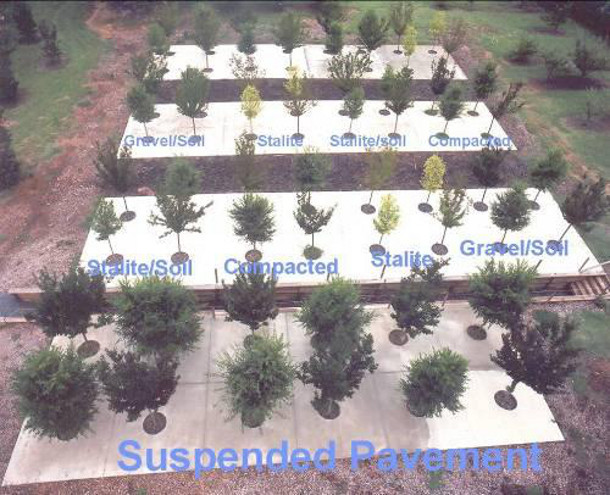
The Bartlett growing media study at 14 months. Note the size of the trees growing in suspended pavement relative to other treatment types.
After 14 months, the suspended pavement over uncompacted soil treatment outperformed all the other soil media in terms of trunk diameter growth, twig growth, chlorophyll rating, and root growth (root growth outperformance was observed in the Elms only). The authors concluded that “suspended pavement over noncompacted soil provided the greatest amount of tree growth and health and should be considered when designed urban planting sites for trees.” Furthermore, they wrote that “The trees in the noncompacted/suspended pavement treatment were larger, faster growing, had better color, and more root growth than most other treatments.”
Nine years later, the difference in performance between trees planted in suspended pavement and trees planted in other treatments remained evident.
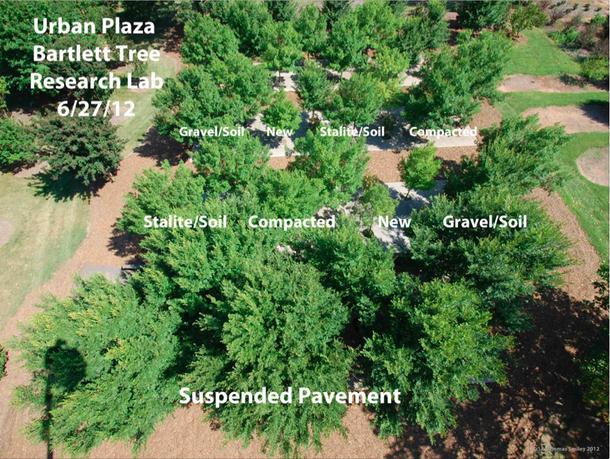
The Bartlett growing media in 2012, after eight growing seasons.
This study is discussed in more detail in the “Where is Suspended Pavement Being Used?” section further down. For more information on this research and its findings, check out updated images and our study-review blog.
What is Suspended Pavement Made Of?
Suspended pavement can be completely customized on a site-by-site basis or it can be constructed using modular systems. In the United States, custom systems are usually constructed using pre-cast or cast-in-place concrete. The earliest suspended pavement projects in North America, to our knowledge, were all constructed in this way.
The DeepRoot Silva Cell, on the other hand, is an example of a modular system. The 24” wide by 48” long by 16” high frame can be stacked to meet the depth of any excavation area and spread laterally as wide as necessary. Utilities can be easily accommodated using a number of tested methods. The Silva Cell is made of a lightweight polypropylene blend, with a galvanized steel tube in the deck for additional strength. Like the earliest concrete suspended pavements, the open framework for the Silva Cell allows almost all of the space to be available for rooting, but is much less expensive than a custom system. Stacks of Silva Cells are attached vertically, but not horizontally, making future excavation and repairs easily to isolate, and maintenance simple.

Silva Cells can be stacked one, two, or three frames deep
Benefits of Trees Growing in Suspended Pavement
Suspended pavements facilitate the growth of healthy trees in urban spaces. Healthy trees have high social and ecological value, including:
- Offering cooling effects via shading and evapotranspiration from the canopy
- Improving air quality by mitigating carbon emissions
- Improving aesthetics and quality of place
- Improving health and well-being
- Encouraging biodiversity due to provision of habitats
Access to useable soil is the most limiting factor for urban tree growth, and few trees have access to soil beyond what is provided in their opening. This is a common reason why street trees often do not grow to maturity or simply fail to thrive. Rooting space becomes limited due to soil compaction that results from paved surfaces/high pedestrian traffic.
Suspended pavement addresses this problem by functioning as a soil-delivery system for trees, allowing lightly compacted, high-quality soils to be stored and made available for tree roots in cities and other heavily paved environments.
With access to adequate amounts of high-quality soil, growing mature and healthy trees in heavily paved environments becomes possible. Properly designed, this technology enables us to grow forest-sized, quality trees — even in urban areas.
Stormwater Management
Healthy, mature trees provide significant stormwater benefits, and suspended pavement systems offer opportunities for integrated stormwater/soil benefits.
If suspended pavement systems are filled with a bioretention soil mix, about 20% of their volume can be used for stormwater storage (for instance: in 1,000 cubic feet of soil volume, 200 cubic feet of water can be stored). Rainwater can be directed into suspended pavement systems in order to keep it on-site, making it available for plant growth and preventing it from overflowing sewer systems or polluting nearby watersheds.
There are many ways to direct water into the system, including pervious pavers, curb cuts, catch basins, slot drains, and more. A typical tree in this amount of soil can hold a significant amount of rainwater, preventing overflow into the impervious surface area — not just under the tree canopy but far beyond the canopy’s edge as well.
The three processes that allow trees in lightly compacted soil to provide stormwater quantity and rate are:
Soil Storage: Soil stores rainwater during and after a storm, making it available for plant growth. Stormwater runoff from nearby impervious surfaces can be directed into the soil under suspended pavement using a number of different techniques: for example, through pervious pavement installed over the cells or via a perforated pipe off a trench drain or manhole.
Interception: Interception is the amount of rainfall temporarily held on tree leaves and stem surfaces. This rain then drips from lead surfaces and flows down the stem surface to the ground or evaporates. Since larger trees have more leaves, they intercept significantly more rain than small trees with interception increasing at a faster rate than tree age.
Evapotranspiration: Evapotranspiration (ET) is the sum of water evaporated from soil and plant surfaces and the water lost as a result of transpiration, a process in which trees absorb water through their roots and transfer it up to the leaves where it evaporates into the environment through leaf pore transpiration. Evapotranspiration continues to reduce stormwater volume stored in the soil long after a rainfall event ends.
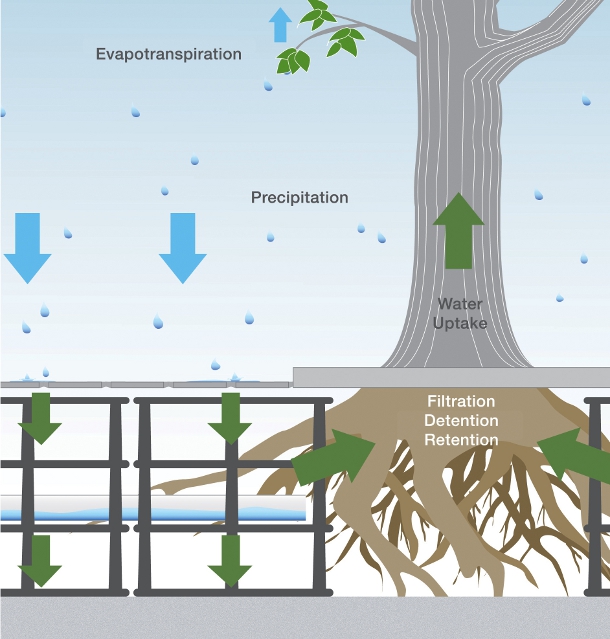
Where is Suspended Pavement Being Used?
What follows are a select few of the numerous projects in which suspended pavement has been utilized, focusing primarily on some of the early adopters.
Bartlett Urban Tree Plaza Study (Charlotte, North Carolina)
This independent study (referenced above) was set up by Dr. Tom Smiley at the Bartlett Tree Laboratory to test how well trees fare in different growing media. The trees were monitored and tracked from year to year to measure their branch extensions, height, diameter at breast height (DBH), leaf count, and more.
The research plots were set up with 12 trees planted in each of five previously mentioned soil treatments, including suspended pavement. All trees had access to 189 cubic feet of growing medium.
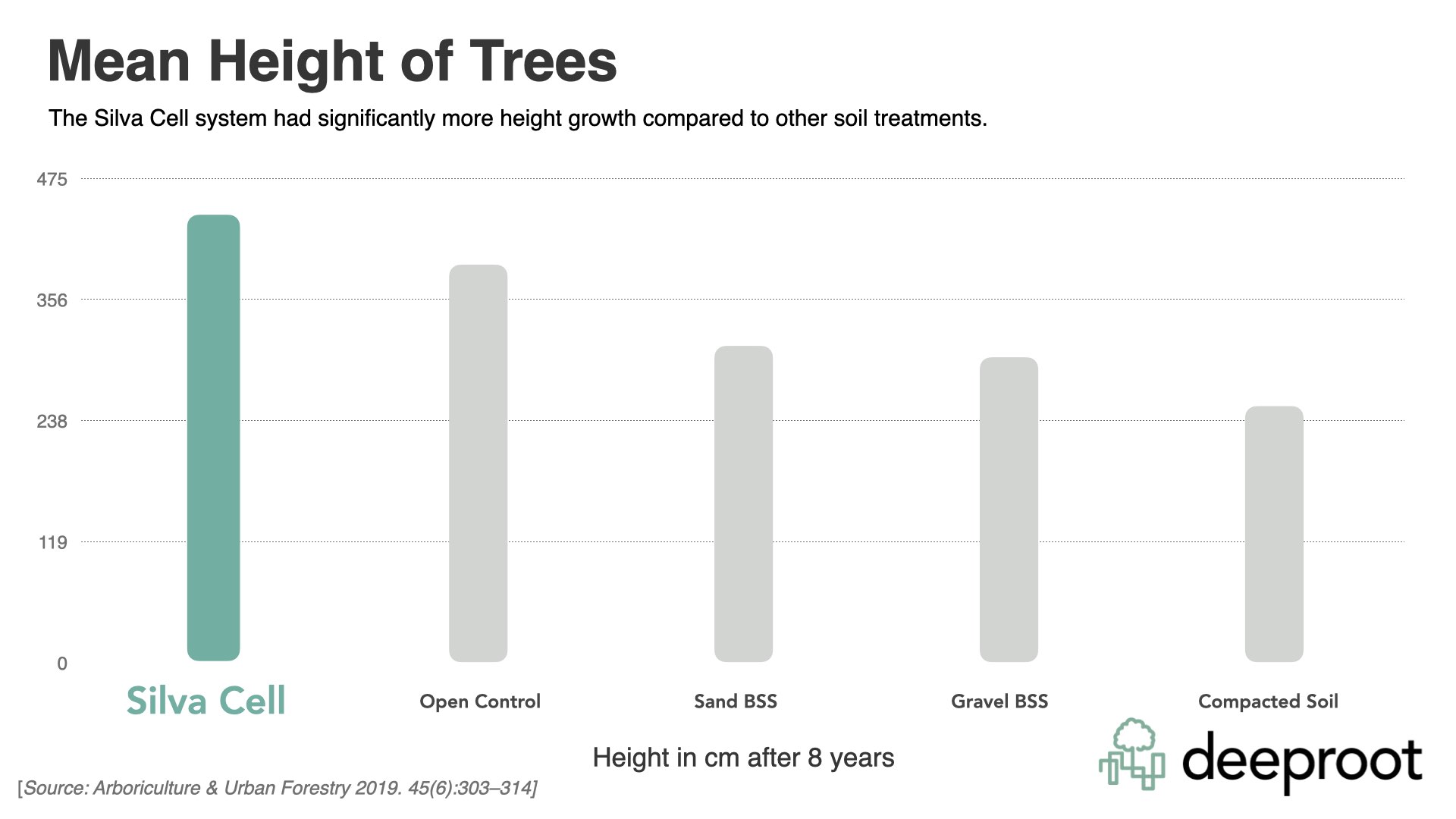
By all measurements, the trees in the suspended pavement treatment outperformed all others in size, color, and root growth.
Christian Science Center (Boston, Massachusetts)
The Christian Science Center, located on Huntington Avenue in Boston, is the oldest suspended pavement installation we know of in the United States. These trees were planted in 1968, making them 55 years old.
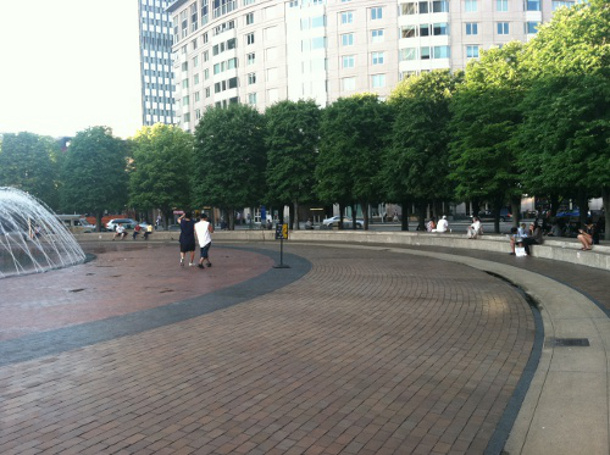
The trees growing in suspended pavement at the Christian Science Center.
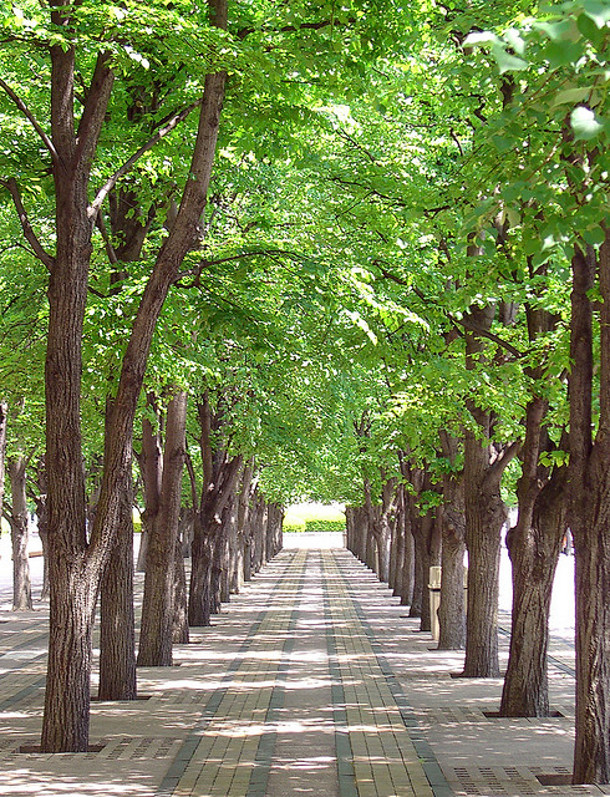
The trees in suspended pavement at the Christian Science Center form a calm and cooling canopy. Flickr credit: walkn
Sasaki & Associates designed this suspended pavement system as a long soil trench made up on structural slabs resting on grade beams over a garage roof. Each tree has access to around 800 cubic feet (22.6 cubic meters) or foil. In 2011, this plaza was designated with landmark status by the Boston Landmark Commission.
Downtown Charlotte Tyson & Trade (Charlotte, North Carolina)
In 1985, Charlotte city arborist Don McSween conceived of a major renovation project along ten blocks of Tyson Street and two blocks of Trade Street — two of the major thoroughfares of the downtown area.
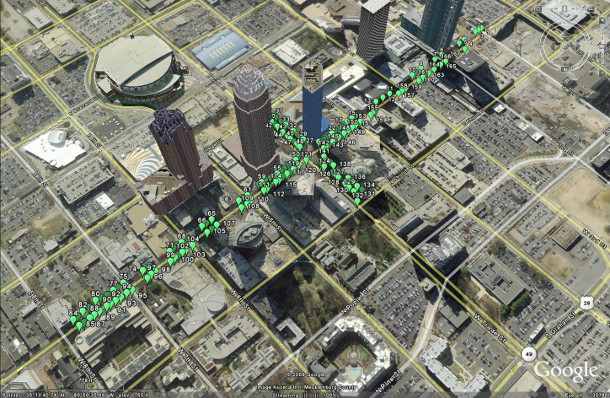
Almost 170 street trees were planted in 700 cubic feet of soil in a suspended pavement system.
McSween wanted each new tree to have 1,000 cubic feet (28 cubic meters) of good, useable soil. In order to supply the trees with that quantity, the city needed to create a custom suspended system using precast concrete pavement support by concrete piers. The whole system was topped by impervious pavers and nearly 170 trees were planted.
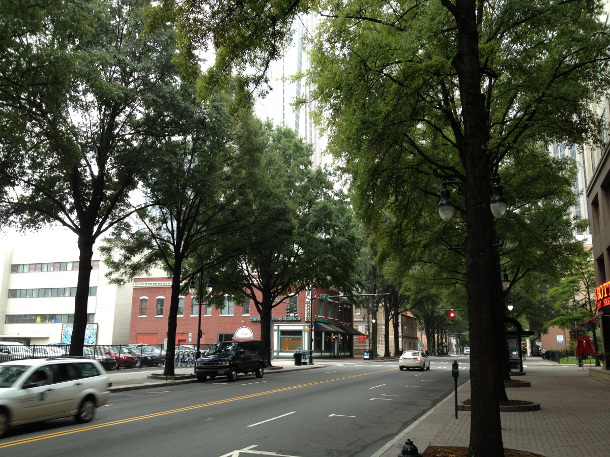
These trees planted in suspended pavement are now 28 years old… and huge.
The trees flourished. In 2009, while investigating trees that weren’t doing so well, Dr. Smiley of the Bartlett Tree Lab discovered that the contractor had actually only installed about 700 cubic feet (20 cubic meters) of soil per tree; however, since the tree pits connected along the length of a block with multiple trees in each pit, they had the benefit of sharing soil. Today, the Willow Oaks (Quercus Phellos) have an average DBH of 19 inches (48.3cm) and an average height of 71 feet (21.64 meters). (Measurements by Dr. Smiley, 2013; MacDonagh & Smiley 2013 ISA Proceedings.)
Lincoln Center Barclay Capital Grove (New York City, New York)
The Barclay Capital Grove at Lincoln Center, installed in 2009, utilizes the DeepRoot Silva Cell system — a modular suspended pavement system composed of structural units that form a skeletal matrix. In this project, the cells cover the entire area of the grove where the trees are planted, although in other cases the depth and layout of the soil volume can cover irregular areas and depths. This increases flexibility in terms of creating appropriate habitat in constrained areas.
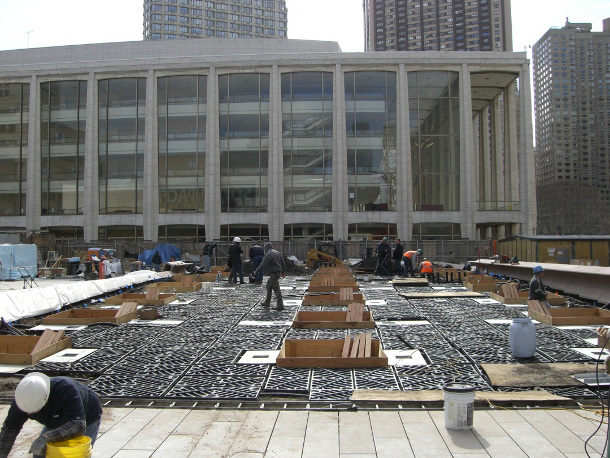
Silva Cells were installed on a parking garage roof at Lincoln Center in 2008
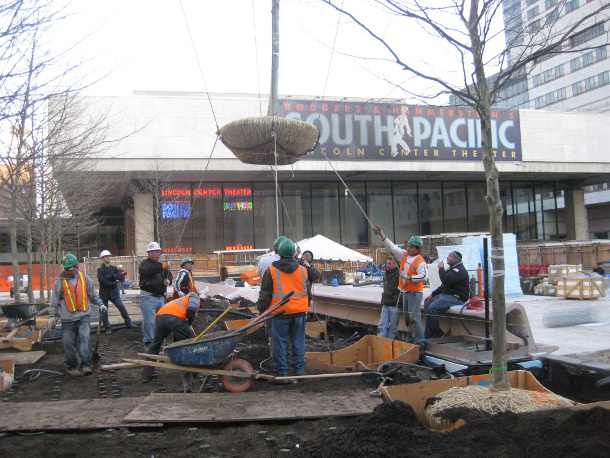
Trees were installed in the Silva Cells in Spring 2009
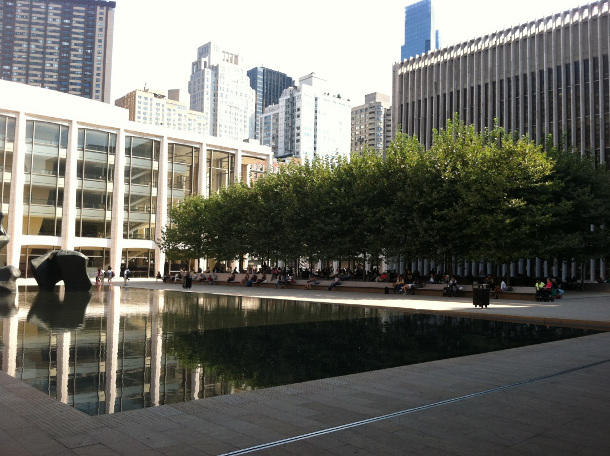
The trees planted in Silva Cells in summer 2012
These trees are planted in a large, shared subsurface planter that rests on an underground parking garage. These trees continue to provide a popular refuge from the elements in the heart of New York City.
Conclusion
There is ample evidence that suspended pavement is an excellent tool for growing trees in a paved environment. At a time when complete streets and sustainable development appear more necessary and have more popular support than ever, this approach to growing trees — not just planting them — is particularly important. In Dr. Smiley’s words from his 2006 article: “The differences in tree growth among treatments was dramatic; trees growing in the noncompacted soil suspended pavement treatment are visually healthier in appearance and provide more shade more quickly than any of the other treatments.
The trees from all of these projects — and there are many others — are a powerful example of how much soil it takes to grow a mature tree, and a reminder that with planning and commitment we can have trees like this in all of our cities.
References / Further Reading and Resources
Landscape Architecture Resource:
Soil and Stormwater Top the List of Sustainable Design
Toronto Ahead of the Curve or Tree Growth and Stormwater Management
Soil in Landscape Design. John Wiley and Sons, New York, NY.
Smiley, E. Thomas, et al. July. 2006. Comparison of Structural and Noncompacted Soils for Trees Surrounded by Pavement. Arboriculture & Urban Forestry.
Interviews with Peter MacDonagh (RLA, ISA, FASLA) and James Urban (FASLA)
Webinar: Using Trees and Soils in Urban Stormwater Management
Webinar: Debunking Myths about Urban Trees and Soil
Trees in Hard Landscapes: A Guide for Delivery
Touch the Soil: Healthy Soils for Healthy Trees
Charlotte, NC Trees in Suspended Pavement Look Great 25 Years Later
Stormwater Quantity and Rate Control Benefits of Trees in Uncompacted Soil

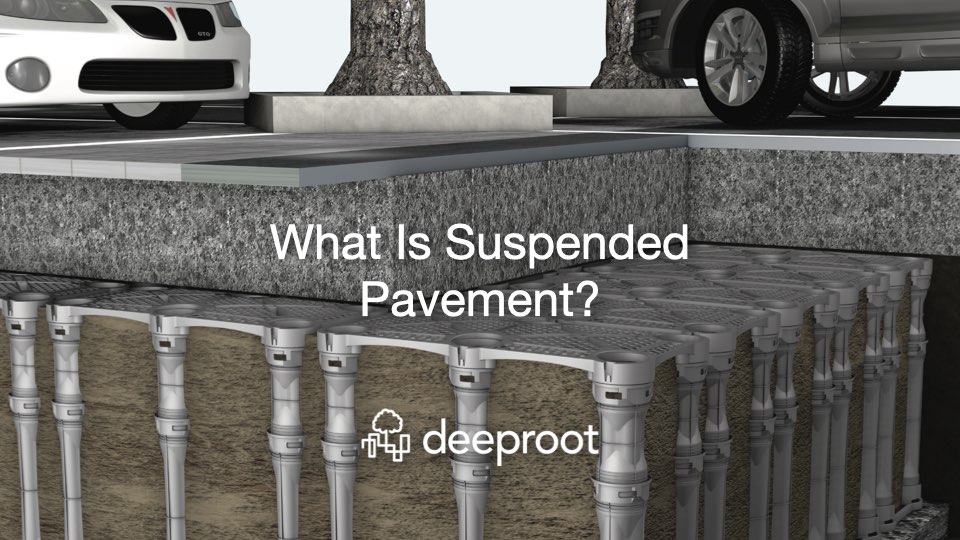




I didn’t know about suspended pavment before, I thought that trees could just grow if you made a little hole in the sidewalk. It seems to me that most big roads in cities have trees alongside them or in the middle, so are they all suspended pavement? I guess that still prevents the roots from messing up the roads right?
Yvon Lebras
It seems great to know about ideas on maintenance and customization of suspended pavement. Thanks for sharing such useful ideas with us!